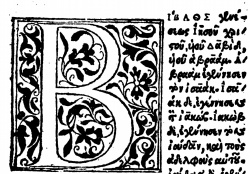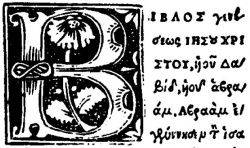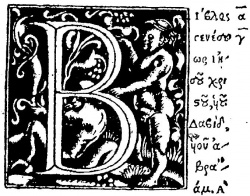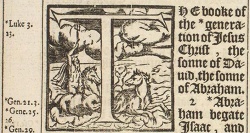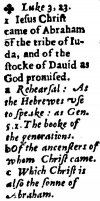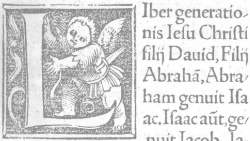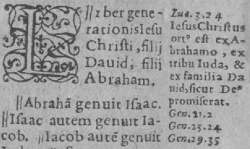Matthew 1:1
From Textus Receptus
(Textus Receptus, Novum Testamentum, Theodore Beza, 5th major edition. Geneva. 1598)
- Matthew 1:1 The book of the generation of Jesus Christ, the son of David, the son of Abraham.
(King James Version, Pure Cambridge Edition 1900)
(King James Version 2016 Edition, 2016)
Interlinear
See Also Matthew 1:1 Interlinear
| Strong's | Greek | Pronunciation | KJV | PKJV | Parts of speech | Case | Tense | Number | Gender | Person | Voice | Mood |
|---|---|---|---|---|---|---|---|---|---|---|---|---|
| 976 | ΒI'BΛΟΣ | vi'-vlos | The book | The book | Noun | Nominative | - | Singular | Feminine | - | - | - |
| 1078 | γενέσεως | yen'-es-ee-ooce' | of the generation | of the generation | Noun | Genitive | - | Singular | Feminine | - | - | - |
| 2424 | Ἰησοῦ | ee-ay-so-oo' | of Jesus | of Jesus | Noun | Genitive | - | Singular | Masculine | - | - | - |
| 5547 | Χριστοῦ | khris-to-oo' | Christ | Christ | Noun | Genitive | - | Singular | Masculine | - | - | - |
| 5207 | υἱοῦ | hwee-oo' | the son | the Son | Noun | Genitive | - | Singular | Masculine | - | - | - |
| 1138 | Δαβὶδ | dav-eeth' | of David | of David | Noun | - | - | - | - | - | - | - |
| 5207 | υἱοῦ | hwee-oo' | the son | the Son | Noun | Genitive | - | Singular | Masculine | - | - | - |
| 11 | Ἀβραάμ | av-rah-arm' | of Abraham | of Abraham | Noun | - | - | - | - | - | - | - |
Commentary
See Also Matthew 1:1 Commentary
Matthew 1:1 is the opening verse of the first chapter of the Gospel of Matthew in the New Testament. Since Matthew is traditionally placed as the first of the four Gospels, this verse commonly serves as the opening to the entire New Testament.
The book
Βίβλος is translated as "The book" and not simply "Book" due to the normal use of anarthrous nouns in titles. This negates the need for italics here in the article 'The.' Anarthrous nouns are generally translated into English with the indefinite article ("a, an"). There are some anarthrous nouns which are qualitative and are often translated without an article.
Βίβλος is the inner bark of the papyrus plant which was made into a written book, a sheet, or scroll of writing. There are seven meanings revealed in scripture:
- 1) It is firstly used here as a book, or scroll (Matthew 1:1),
- 2) concerning the Pentateuch as the "book" of Moses in Mark 12:26,
- 3) regarding "the book of the words of Isaiah" that Jesus read from in Luke 3:4,
- 4) the "book of Psalms" in Luke 20:42 and also in Acts 1:20,
- 5) as "the prophets" in Acts 7:42,
- 6) as "the Book of Life" in Philippians 4:3, Revelation 3:5, 20:15
- 7) and of secular writings in Acts 19:19.
The English word Bible stems from the Greek Βίβλος. Interestingly the English word paper comes from papyrus. Because Beech wood tablets were a common writing material in Germanic societies before the development of paper, the Old English bōc and Old Norse bók both have the primary sense of “beech” but also a secondary sense of “book,” and it is from bōc that the modern word book derives. In modern German, the word for “book” is Buch, with Buche meaning “beech tree.” In the Swedish language, these words are the same, bok meaning both “beech tree” and “book.”
See Also Βίβλος, Book, Bible, Papyrus, and Anarthrous nouns.
of the generation
γενέσεως of the generation, means to be generated or to be placed in time, where the origination of the eternal Christ's body occurred and the Word became flesh. Christ was not generated from man, but through Mary and from God, linking to verse 18. The genealogy mentioned is of Joseph, and not Jesus. Thus the New King James Version's translation is faulty having "The genealogy of Jesus Christ" because Christ had no genealogy except through His mother.
The exact phrase 'Βίβλος γενέσεως' (at times the book of the genealogy) is used in Genesis 2:4 and 5:1 in the so called Greek Septuagint. This is correct because it concerns God's creation and also to genealogies of man, whereas in Matthew 1:1, it is applied to the eternal, uncreated, Son of God, an thus is translated as generation. The LXX has:
- αὕτη ἡ βίβλος γενέσεως οὐρανοῦ καὶ γῆς ὅτε ἐγένετο ᾗ ἡμέρᾳ ἐποίησεν ὁ θεὸς τὸν οὐρανὸν καὶ τὴν γῆν Genesis 2:4
- αὕτη ἡ βίβλος γενέσεως ἀνθρώπων ᾗ ἡμέρᾳ ἐποίησεν ὁ θεὸς τὸν αδαμ κατ’ εἰκόνα θεοῦ ἐποίησεν αὐτόν. Genesis 5:1
See Also Genesis 37:2 and Numbers 3:1.
In Hebrew the phrase "book of the genealogy" sepher toledoth (סֵפֶר תֹּולְדֹת) is frequent in Jewish writing. The other genealogy concerning the linage of the family of Jesus appears in Luke 3:23-38. This genealogical list here in Matthew is necessary to prove the linage and pedigree of Jesus Christ's family, and that being raised in the house of Joseph who was the "Son of David" and "Son of Abraham" He fulfills the requirements relating to the prophecies about the coming Messiah.
While some believe the phrase 'Βίβλος γενέσεως' to be merely a title for the first part of the gospel of Matthew (1-17) and not a title to the Gospel of Matthew, nor for the entire New Testament itself, it is most probably linked to verse 18, where Jesus is generated from God, rather than produced through men in the genealogy of verse 2-17. It must be noted that the generation of Jesus Christ, applies to Christ's entire life. Nowhere else in the New Testament does book refer to anything other than an entire work. So it is erroneous to conclude that it is only concerned with the listed genealogy.
While the long genealogy of names may be of little interest to most modern readers, lineage and descent were of great importance in Jewish society of the time, and a family descent from David and Abraham was crucial to accepting Jesus as the Messiah. The names, at least in the first part of the genealogy, would have been well known to readers. The genealogy provides proof that the promise of mankind's future salvation made in Genesis 3:15 through the "Seed of the woman" is fulfilled in Jesus of Nazareth.
See Also Genealogy of Jesus
of Jesus Christ
Ἰησοῦ The Hebrew Yeshua means "the LORD is salvation."
Beza's 1598 has ȣ for οῦ in this and many other places. The οῦ has been retained above for ease of reading.
Χριστοῦ. Christ meaning - The Messiah, anointed one. The word anointed means to be placed into a position, like a king or a priest. A similar word is appointed.
the Son of David
υἱοῦ Δαβίδ. The "Son of David" (בֶּן דָּוִד,is a title of the Messiah, the Savior. Matthew 15:22, 20:20, 21:15; Mark 10:47; and Luke 18:38.
Some manuscripts spell Δαβίδ as Δαυεὶδ (with υε in place of a β) and Δαυὶδ (with υ in place of a β). Δαυεὶδ and Δαυὶδ are also forms in the Greek Septuagint.
the Son of Abraham
υἱοῦ Ἀβραάμ. The "Son of Abraham" reveals that Christ is the promised Seed of the Abrahamic covenant. While the title "Son of David" was a common messianic title, "son of Abraham" was an expression that could refer to any Jew.
The MEV has son without the capital S.
Early Church Fathers
- Βίβλος, φησὶ, γενέσεως Ἰησοῦ Χριστοῦ, υἱοῦ Δαβίδ, υἱοῦ Ἀβραάμ. Origen (Commentary of St. John’s Gospel, vol. 1, A.E. Brooke, p 6, 20)
- Βίβλος γενέσεως Ἰησοῦ Χριστοῦ υἱοῦ Δαβίδ υἱοῦ Ἀβραάμ Eusebius of Caesarea (Demonstratio Evangelica, p337, 14, Eusebius Werke, Ivar A. Heikel)
Greek
Textus Receptus
Complutensian Polyglot
See Also Matthew 1:1 Complutensian Polyglot 1514
Aldine
Desiderius Erasmus
- 1516 ΒΙΒΛΟΣ γενέσεως ΙΗΣΟΥ ΧΡΙΣΤΟΥ, υἱοῦ Δαβίδ, υἱοῦ άβραάμ (Erasmus 1st Novum Instrumentum omne)
- 1519 Βίβλος γενέσεως Ἰησοῦ Χριστοῦ, υἱοῦ Δαβίδ, υἱοῦ άβραάμ (Erasmus 2nd Novum Testamentum omne)
- 1522 Βίβλος γενέσεως Ἰησοῦ Χριστοῦ, υἱοῦ Δαβίδ, υἱοῦ άβραάμ (Erasmus 3rd Novum Testamentum omne)
- 1527 Βίβλος γενέσεως Ἰησοῦ Χριστοῦ, υἱοῦ Δαβίδ, υἱοῦ άβραάμ. (Erasmus 4th Novum Testamentum omne)
- 1535 (Erasmus 5th Novum Testamentum omne)
Colinæus
Stephanus (Robert Estienne)

- 1546 ΒΙΒΛΟΣ γενέσεως ἱῦ χῦ υἱοῦ δαβίδ υἱοῦ άβραάμ. (Robert Estienne (Stephanus) 1st) (See Also Nomina sacra)
- 1549 (Robert Estienne (Stephanus) 2nd)
- 1550 Βίβλος γενέσεως Ἰησοῦ Χριστοῦ, υἱοῦ Δαβίδ, υἱοῦ Ἀβραάμ (Robert Estienne (Stephanus) 3rd - Editio Regia)
- 1551 Βίβλος γενέσεως Ἰησοῦ Χριστοῦ, υἱοῦ Δαβίδ, υἱοῦ Ἀβραάμ (Robert Estienne (Stephanus) 4th)
Theodore Beza
- 1565 ΒIBΛΟΣ γενέσεως Iησοῦ Χριστου, υἱοῦ Δαβίδ, υἱοῦ Ἀβραάμ. (Theodore Beza, Novum Testamentum, cum versione Latina veteri, et nova Theodori Bezæ. Geneva)

- 1565 (Beza Octavo 1st)
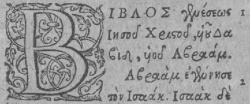
- 1567 ΒIBΛΟΣ γενέσεως Iησοῦ Χριστου, υἱοῦ Δαβίδ, υἱοῦ Ἀβραάμ. (Beza Octavo 2nd)
- 1580 (Beza Octavo 3rd)
- 1582 (Theodore Beza, Novum Testamentum. 2nd folio edition. Geneva.)
- 1588 ΒI'BΛΟΣ γενέσεως Ἰησοῦ Χριστου, υἱοῦ Δαβίδ, υἱοῦ Ἀβραάμ (Theodore Beza, Novum Testamentum. 3rd folio edition. Geneva.)
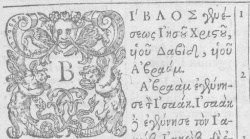
- 1590 (Beza Octavo 4th)
- 1598 ΒI'BΛΟΣ γενέσεως Ἰησοῦ Χριστοῦ, υἱοῦ Δαβίδ, υἱοῦ Ἀβραάμ (Theodore Beza, Novum Testamentum. 4th folio edition. Geneva.)
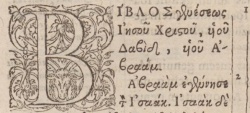
See Also Matthew 1:1 Beza 1598 (Beza)
- 1604 (Beza Octavo 5th)
Elzevir
- 1624 ΒΊΒΛΟΣ γενέσεως Ἰησοῦ Χριστοῦ, υἱοῦ Δαβίδ, υἱοῦ Ἀβραάμ. Isaac Elzevir of House of Elzevir, Novum Testamentum Græce. Lugduni Batavorum [Leiden]: Ex officina Elzeviriana, 1624
- 1633 (Textus Receptus, Novum Testamentum Græce, Isaac Elzevir of House of Elzevir, Lugduni Batavorum [Leiden]: Ex officina Elzeviriana, 1633) (Elzevir) edited by Jeremias Hoelzlin, Professor of Greek at Leiden.
- 1641 (Elzevir 1641) (Elzevir)
- 1679 (Elzevir 1679) (Elzevir)
Oxford Press
Scholz
- Footnote Rec. Δαβίδ. [et sic passim].
Scrivener
- 1880 Βίβλος γενέσεως Ἰησοῦ Χριστοῦ, υἱοῦ Δαβίδ, υἱοῦ Ἀβραάμ. (F. H. A. Scrivener , The New Testament in the Original Greek according to the Text followed in the Authorised Version - Cambridge University Press).
Other Greek
- 350 Βίβλος γενεσεως IY ΧY υἱοῦ Δαυεὶδ υἱοῦ Aβρααμ (Codex Vaticanus) 1209 (B or 03) (von Soden δ1) - Vatican Library (See Also Nomina sacra)
- 360 Βιβλος γενεσεως IY ΧY ὑϊου ΔAΔ ὑϊου Ἀβρααμ (Codex Sinaiticus) (א or 01) (von Soden δ2) - British Library Leipzig University Saint Catherine's Monastery (See Also Nomina sacra)
- 400 - 500 Βίβλος γενέσεως IY ΧY υἱοῦ Δ[...]δ ὑϊου Aβρααμʼ (Codex Washingtonianus) (W or 032) (von Soden ε014) (See Also Nomina sacra)
- 700 - 800 Βιβλος γενεσεως ΙΥ ΧΥ ΥΥ ΔΑΔ ΥΥ Αβρααμ· Codex Basilensis (Ee or 07) (von Soden ε55) (See Also Nomina sacra)
- 900 - 1000 Βιβλος γενέσεως ΙΥ ΧΥ· ὑιου ΔΑΔ· ὑιου Ἀβραάμ· (Codex Cyprius (K or 017) (von Soden ε71) (See Also Nomina sacra)
- 1000 - 1100 Βίβλος γενέσεως ιυ χυ υἱοῦ δαδ͵ υἱοῦ ἀβραάμ· (Minuscule 652 (von Soden ε1095) (See Also Nomina sacra)
- 1000 - 1100 Βίβλος γενέσεως ἰυ χυ υἱοῦ δαδ υἱοῦ ἀβραάμ· (Minuscule 43 (8409) (See Also Nomina sacra)
- 1000 - 1100 Βίβλος γενέσεως ιυχυ υυ δαδ υυ ἀβραάμ· (Minuscule 65 (von Soden ε135) Harley MS 5776 (See Also Nomina sacra)
- 1000 - 1100 Βιβλος γενεσεως ιυ χυ υιου δαδ υιου αβρααμ. (Minuscule 72 (von Soden ε110) Harley MS 5647 (See Also Nomina sacra)
- 1100 - 1200 Βιβλος γενεσεως ιυ χυ· υἱου δαδ· υιου αβρααμ· (Minuscule 44 (von Soden ε239) Add MS 4949 (See Also Nomina sacra)
- 1100 - 1200 Βιβλος γενεσεως ιυ χυ· υιου δαδ· υἱȣ* αβρααμ· (Minuscule 57 (von Soden δ255) MS. Gr. 9 (See Also Nomina sacra) * ȣ = οῦ
- 1033 Βίβλος γενέσεως ἰυ χυ· υιου δαδ· υιου αβρααμ· (Minuscule 504 (von Soden ε111) Add MS 17470) (See Also Nomina sacra)
- 1133 Βίβλος γενέσεως ιυ χυ· υιȣ δαδ· υιου ἀβραάμ· (Minuscule 1152, Ms. 129) (See Also Nomina sacra) * ȣ = οῦ
- 1300 - 1400 Bἱβλος γενέσεως ιυ χυ · υἱοῦ δαδ · υἱοῦ ἀβραάμ· (Minuscule 561 (von Soden ε1289) Ms. Hunter 476) (See Also Nomina sacra)
- 1707 ΒIBΛΟΣ γενέσεως IHΣΟΥ Χριστου, υἱοῦ Δαβίδ, υἱοῦ Ἀβραάμ. (John Mill)
- 1734 ΒIBΛΟΣ γενέσεως ἰησοῦ χριστοῦ, υἱοῦ δαυίδ, υἱοῦ ἀβραάμ. (Bengel)
- 1751 Βίβλος γενέσεως Ἰησοῦ Χριστοῦ, υἱοῦ Δαβίδ, υἱοῦ Ἀβραάμ. (Wettstein)
- 1803 Βίβλος γενέσεως Ἰησοῦ Χριϛοῦ, υἱοῦ δαυίδ, υἱοῦ ἂβραάμ. (Christian Frederick Matthaei)
- 1809 ΒIBΛΟΣ γενέσεως Ἰησȣ Χριϛȣ* υἱοῦ Δαβίδ υἱȣ Ἀβραάμ. (Johann Jakob Griesbach) * ȣ = οῦ
- 1830 Βίβλος γενέσεως Ἰησοῦ Χριστοῦ υἱοῦ Δαυίδ υἱοῦ Ἀβραάμ. (Scholz)
- 1831 Βίβλος γενέσεως Ἰησοῦ Χριστοῦ υἱοῦ Δαυεὶδ υἱοῦ Ἀβραάμ. (Lachmann)
- 1840 Βίβλος γενέσεως Ἰησοῦ Χριστοῦ, υἱοῦ Δαυὶδ, υἱοῦ Ἀβραάμ. (Tittman)
- 1852 Βίβλος γενέσεως Ἰησοῦ Χριστοῦ, υἱοῦ Δαυὶδ, υἱοῦ Ἀβραάμ Theile
- 1855 ΒIBΛΟΣ γενέσεως Ἰησοῦ Χριστου, υἱοῦ Δαυὶδ, υἱοῦ Ἀβραάμ. (Bloomfield)
- 1857 Βίβλος γενέσεως Ἰησοῦ Χριστοῦ υἱοῦ Δαυεὶδ υἱοῦ Ἀβραάμ (Tregelles' Greek New Testament)
- 1863 Βίβλος γενέσεως Ἰησοῦ Χριστοῦ υἱοῦ Δαυεὶδ υἱοῦ Ἀβραάμ. (Alford)
- 1869 Βίβλος γενέσεως Ἰησοῦ Χριστοῦ υἱοῦ Δαυεὶδ υἱοῦ Ἀβραάμ. (Tischendorf)
- 1872 ΒIBΛΟΣ γενέσεως Ἰησοῦ Χριστοῦ υἱοῦ Δαυεὶδ υἱοῦ Ἀβραάμ. (Wordsworth)
- 1881 ΒIBΛΟΣ γενέσεως Ἰησοῦ Χριστοῦ υἱοῦ Δαυὶδ υἱοῦ Ἀβρααμ. (Westcott & Hort)
- 1904 Βίβλος γενέσεως Ἰησοῦ Χριστοῦ υἱοῦ Δαυεὶδ υἱοῦ Ἀβρααμ. (Nestle)
- 1904 Βίβλος γενέσεως Ἰησοῦ Χριστοῦ, υἱοῦ Δαυῒδ υἱοῦ Ἀβραάμ. (Greek Orthodox (B. Antoniades))
- 1905 Βίβλος γενέσεως Ἰησοῦ Χριστοῦ υἱοῦ, Δαυεὶδ, υἱοῦ Ἀβρααμ. (Weiss)
- 1913 Βίβλος γενέσεως Ἰησοῦ Χριστοῦ υἱοῦ Δαυὶδ υἱοῦ Ἀβραάμ. (von Soden)
Anglo Saxon Translations
- 1000 her is on cneorisse-bóc hælendes cristes dauides suna. Abrahames suna. (Anglo-Saxon Gospels Manuscript 140, Corpus Christi College by Aelfric)
- 1200 Soðliche wel is to understanden þæt æfter matheus ge-rechednysse her is on cneornysse boc. hælendes cristes dauiðes suna. abrahames suna. (Anglo-Saxon Gospels Hatton Manuscript 38, Bodleian Library by unknown author)
English Translations
- 1380 The book of the generacioun of ihesus crist; the sone of dauith, the sone of abraham, (Wyclif's Bible by John Wycliffe)
- 1395 The book of the generacioun of Jhesu Crist, the sone of Dauid, the sone of Abraham. (Wyclif's Bible by John Wycliffe)
- 1534 This is the boke of the generacion of Iesus Christ the sonne of Dauid, the sonne also of Abraham. (Tyndale Bible by William Tyndale)
- 1535 This is the boke of the generacion of Iesus Christ the sonne of Dauid, the sonne of Abraham. (Coverdale Bible)
- 1539 (Great Bible First Edition - Miles Coverdale)
- 1540 Thys ys þe booke of the generacyon of Iesus Chryst, þe sonne of Dauid, the sonne of Abraham. (Great Bible Second Edition - Miles Coverdale)
- 1549 Thys is þe boke of þe generation of Iesus Christ þe sonne of dauyd, þe sonne also of Abraham. (Matthew's Bible - John Rogers)
- 1557 The Booke of the generation of Iesus Christe, the sonne of Dauid, the sonne of Abraham. (Geneva 1557) by William Whittingham
- 1560 THe boke of the generaciό of IESVS CHRIST, the sonne of Dauid, the sonne of Abraham.
- 1568 This is the booke of the generation of Iesus Christ, the sonne of Dauid, the sonne of Abraham. (Bishop's Bible First Edition)
- 1572 This is the booke of the generation of Iesus Christ, the sonne of Dauid, the sonne of Abraham. (Bishop's Bible)
- 1582 The booke of the generation of IESVS Christ, the sonne of Dauid, the sonne of Abraham. (Rheims 1582)
- 1587 The booke of the generation of Iesvs Christ the sonne of Dauid, the sonne of Abraham (Geneva Bible) by William Whittingham
- 1599 The booke of the generation of Iesus Christ the sonne of Dauid, the sonne of Abraham. (Geneva Bible) by William Whittingham
- 1611 The booke of the generation of Iesus Christ, the sonne of Dauid, the sonne of Abraham. (King James Version)
- 1729 The History of the life of Jesus Christ, the son of David, the son of Abraham. (Mace New Testament)
- 1745 THE book of the generation of Jesus Christ, the son of David, the son of Abraham. (Mr. Whiston's Primitive New Testament)
- 1762 (King James Version)
- 1769 The book of the generation of Jesus Christ, the son of David, the son of Abraham. (King James Version - Benjamin Blayney)
- 1770 (Worsley Version by John Worsley)
- 1790 (Wesley Version by John Wesley)
- 1795 (A Translation of the New Testament from the Original Greek by Thomas Haweis)
- 1833 The book of the generation of Jesus Christ, the son of David, the son of Abraham. (Webster Version - by Noah Webster)
- 1835 The History of Jesus Christ, Son of David, Son of Abraham. (Living Oracles by Alexander Campbell)
- 1849 THE RECORD of the generation of Jeshu the Meshicha, the son of David, son of Abraham. (Etheridge Translation by John Etheridge)
- 1850 (King James Version by Committee)
- 1851 THE book of the nativity of Jesus the Messiah, the son of David, son of Abraham. (Murdock Translation)
- 1855 Calvin Bible by the Calvin Translation Society
- 1858 (The New Testament Translated from the Original Greek by Leicester Sawyer)
- 1865 A record of descent of Jesus Anointed, son of David, son of Abraham. (The Emphatic Diaglott by Benjamin Wilson)
- 1865 BOOK of the generation of Jesus Christ, son of David, son of Abraham. (The New Testament of Our Lord and Savior Jesus Christ 1865 by American Bible Union)
- 1869 (Noyes Translation by George Noyes)
- 1873 THE book of the generation of Jesus Christ, the son of David, the son of Abraham. (King James Version) by Frederick Scrivener)
- 1885 (Revised Version also called English Revised Version - Charles Ellicott editor)
- 1890 Book of the generation of Jesus Christ, Son of David, Son of Abraham. (Darby Version 1890 by John Darby)
- 1898 A roll of the birth of Jesus Christ, son of David, son of Abraham. (Young's Literal Translation by Robert Young)
- 1901 The book of the generation of Jesus Christ, the son of David, the son of Abraham. (American Standard Version - Philip Schaff)
- 1902 The Lineage Roll of Jesus Christ,––Son of David, Son of Abraham. (The Emphasised Bible Rotherham Version)
- 1902 (Translation of the New Testament from the Original Greek by William Godbey)
- 1904 (The New Testament: Revised and Translated by Adolphus Worrell)
- 1904 (Twentieth Century New Testament by Ernest Malan and Mary Higgs)
- 1911 (Syrus Scofield)
- 1912 The Genealogy of Jesus Christ, the son of David, the son of Abraham. (Weymouth New Testament)
- 1918 (The New Testament Translated from the Sinaitic Manuscript by Henry Anderson)
- 1923 The ancestry of Jesus Christ, who was descended from David, who was descended from Abraham. (Edgar Goodspeed)
- 1982 (New King James Version) Copyright © 1982 by Thomas Nelson.
- 1984 (New International Version)(NIV) Holy Bible, New International Version®, NIV® Copyright © 1973, 1978, 1984, 2011 by Biblica, Inc.®
- 1995 (New American Standard Bible) NASB (©1995)
- 1999 (American King James Version)AKJV
- 2000 (King James 2000 Bible©)
- 2005 (Today’s New International Version)
- (BBE)
- 2009 (Holman Christian Standard Bible)(HCSB) Copyright © 1999, 2000, 2002, 2003, 2009 by Holman Bible Publishers, Nashville Tennessee. All rights reserved.
- (21st Century King James Version) Copyright © 1994 by Deuel Enterprises, Inc.
- (Common English Bible) Copyright © 2011 by Common English Bible
- (GOD’S WORD Translation)(GW) Copyright © 1995 by God's Word to the Nations.
- (Contemporary English Version)(CEV) Copyright © 1995 by American Bible Society
- (New Living Translation)(NLT) Holy Bible. New Living Translation copyright© 1996, 2004, 2007, 2013 by Tyndale House Foundation.
- (Amplified Bible) Copyright © 1954, 1958, 1962, 1964, 1965, 1987 by The Lockman Foundation
- (The Message) (MSG) Copyright © 1993, 1994, 1995, 1996, 2000, 2001, 2002 by Eugene H. Peterson
- (New International Reader's Version) (NIRV) Copyright © 1995, 1996, 1998, 2014 by Biblica, Inc.®.
- (Wycliffe New Testament)
Foreign Language Versions
Afrikaans
- 1933 (Ta Biblia Ta Logia)
- 1953 Die geslagsregister van Jesus Christus, die seun van Dawid, die seun van Abraham:
- 1983 © Bybelgenootskap van Suid Afrika
Akan
Albabian
- Abrahamit i lindi Isaku; Isakut i lindi Jakobi; Jakobit i lindi Juda dhe vëllezërit e tij.
Amuzgo de Guerrero
Armenian
- Աբրահամ ծնաւ Իսահակը. Իսահակ ծնաւ Յակոբը. Յակոբ ծնաւ Յուդան ու անոր եղբայրները.
Arabic
- 1516
- 1591
- 1616
- 1622
- 1671 Biblia Arabica. de propaganda fide. Arabic and Latin Bible printed in Rome by Abraham Ecchellensis and Louis Maracci
- كتاب ميلاد يسوع المسيح ابن داود ابن ابراهيم (Arabic Smith & Van Dyke)
- 1988 Arabic Life Application Bible (ALAB) Copyright © 1988 by Biblica
- 2009 Arabic Bible: Easy-to-Read Version (ERV-AR) Copyright © 2009 by World Bible Translation Center
Aramaic
- ܟܬܒܐ ܕܝܠܝܕܘܬܗ ܕܝܫܘܥ ܡܫܝܚܐ ܒܪܗ (Aramaic Peshitta)
Basque
- 1571 IESVS CHRIST Dauid-en semearen, Abrahamen semearen generationeco Liburuä.
Bulgarian
- 1940 Родословието на Исуса Христа, син на Давида, син на Авраама. (Матей 1:1) (1940 Bulgarian Bible)
- Родословието на Исуса Христа, син на Давида, син на Авраама. (Матей 1:1) (Bulgarian Bible)
Cherokee
- 1860 ᎯᎠ ᎪᏪᎵ ᎧᏃᎮᎭ ᏧᏁᏢᏔᏅᏒ ᏥᏌ ᎦᎶᏁᏛ, ᏕᏫ ᎤᏪᏥ, ᎡᏆᎭᎻ ᎤᏪᏥ. Cherokee New Testament (CHR)
Chinese
- 1 亚 伯 拉 罕 的 後 裔 , 大 卫 的 子 孙 ( 後 裔 子 孙 原 文 都 作 儿 子 下 同 ) , 耶 稣 基 督 的 家 谱 : (馬 太 福 音 1:1) (Chinese Union Version (Simplified))
- 1 亞 伯 拉 罕 的 後 裔 , 大 衛 的 子 孫 ( 後 裔 子 孫 原 文 都 作 兒 子 下 同 ) , 耶 穌 基 督 的 家 譜 : (馬 太 福 音 1:1) (Chinese Union Version (Traditional))
Croatian
Czech
Danish
Dutch
Esperanto
Finnish
French
- Livre de la généalogie de Jésus Christ, fils de David, fils d'Abraham: (French Darby)
- 1744 Le Livre de la Généalogie de Jésus-Christ, fils de David, fils d'Abraham. (Martin 1744)
- 1744 Livre généalogique de JÉSUS-CHRIST, fils de David, fils d'Abraham. (Ostervald 1744)
- 1864 (Augustin Crampon)
- 1910
- 2006 (King James Française)
German
- 1545 Dies ist das Buch von der Geburt Jesu Christi, der da ist ein Sohn Davids, des Sohnes Abrahams. (Luther 1545)
- 1871 Buch des Geschlechts Jesu Christi, des Sohnes Davids, des Sohnes Abrahams. (Elberfelder 1871)
- 1912 Dies ist das Buch von der Geburt Jesu Christi, der da ist ein Sohn Davids, des Sohnes Abrahams. (Luther 1912)
Greek
- 1904 Βίβλος γενέσεως Ἰησοῦ Χριστοῦ, υἱοῦ Δαυῒδ, υἱοῦ Ἀβραάμ. (Greek Orthodox (B. Antoniades))
- ΒΙΒΛΟΣ τῆς γενεαλογίας τοῦ Ἰησοῦ Χριστοῦ, υἱοῦ τοῦ Δαβίδ, υἱοῦ τοῦ Ἀβραάμ. Modern Greek (Trinitarian Bible Society)
Hungarian
Indonesian
Italian
- 1649 LIBRO della generazione di Gesù Cristo, figliuolo di Davide, figliuolo di Abrahamo. (Giovanni Diodati Bible 1649)
- 1927 Genealogia di Gesù Cristo figliuolo di Davide, figliuolo d’Abramo. (Riveduta Bible 1927)
Japanese
- 1928 アラハムの子、ダビデの子、イエスキリストの系図(けいず)の巻(かん) (Naoji Nagai)
Kabyle
Latin
- liber generationis Iesu Christi filii David filii Abraham Latin Vulgate
- 1527 Liber generationis Iesu Christ fili Dauid, fili Abraham. (Erasmus 1527)
- 1527 liber generationis Iesu Christi filii David filii Abraham (Erasmus Vulgate 1527)
- 1565 (Beza)
- 1598 (Beza)
Latvian
Maori
- 1833
- 1837
- 1858
- 1868 (Formal translation based on the Greek 'Received Text': Trinitarian Bible Society)
- 1833
- 1952
Norwegian
- 1930 Jesu Kristi, Davids sønns, Abrahams sønns ættetavle:
Pidgin
- 1996 Dispela em i buk bilong ol man i wanlain bilong Jisas Kraist. Em i pikinini man bilong Devit, na Devit em i pikinini man bilong Ebraham. (Pidgin King Jems)
Portugese
Potawatomi
- 1833 (Potawatomi Matthew and Acts)
Romainian
- 2010 Cartea naşterii lui Isus Cristos, fiul lui David, fiul lui Avraam. (Biblia Traducerea Fidela în limba română)
Russian
- 1876 1 - Родословие Иисуса Христа, Сына Давидова, Сына Авраамова. Russian Synodal Version
- Phonetically: Rodoslovie Iisusa Hrista, Syna Davidova, Syna Avraamova.
Shur
Spanish
See Also Bible translations (Spanish)
- 1569 (Sagradas Escrituras)
- 1909 (Reina-Valera)
- 1987 Translation from English. Publisher: Watch Tower Bible and Tract Society.
- 1994 Nuevo Testamento versión Recobro
- 1997 (La Biblia de las Américas) (©1997)
- 1999 Nueva Versión Internacional (NVI)
- 2009 Santa Biblia: Reina-Valera
- 1 El libro de la generación de Jesucristo, hijo de David, hijo de Abraham. (RVG Spanish)
Swahili
Swedish
- 1917 Detta är Jesu Kristi, Davids sons, Abrahams sons, släkttavla. (Swedish - Svenska 1917)
Tagalog
- 1905 Ang aklat ng lahi ni Jesucristo, na anak ni David, na anak ni Abraham. (Ang Dating Biblia 1905)
Thai
(Thai KJV)
Turkish
Ukrainian
Urdu
- سُوع مسِیح اِبنِ داؤُد اِبنِ ابرہا م کا نسب نامہ۔ (Revised Version)
- Yisu Masih, ibn Daud, ibn i Abiraham, ka nasabnama. (Roman Script)
Vietnamese
- 1934 Gia phổ Đức Chúa Jêsus Christ, con cháu Đa-vít và con cháu A�p-ra-ham. (Ma-thi-ô 1:1 Vietnamese Bible) (VIET)
Welsh
- 1567 (William Salesbury, printed in 1567 by Humphrey Toy)
- 1588 (William Morgan)
- 1620 (William Morgan)
- 1824
- 1988 (New Welsh Bible)
- 2004
- 2011 (beibl.net 2011 by Arfon Jones)
Critical Apparatus
Commentaries
- Abbott's Illustrated New Testament
- Adam Clarke Commentary
- Barnes' Notes on the Whole Bible
- Calvin's Commentary on the Bible
- Cambridge Greek Testament for Schools and Colleges
- Justin Edwards' Family Bible New Testament
- John Gill's Exposition of the Whole Bible
- Geneva Study Bible
- Greek Testament Critical Exegetical Commentary
- Heinrich Meyer's Critical and Exegetical Commentary on the New Testament
- Johann Albrecht Bengel's Gnomon of the New Testament
- Commentary Critical and Explanatory on the Whole Bible
- John Lightfoot's Commentary on the Gospels
- John Trapp Complete Commentary
- The Popular Commentary by Paul E. Kretzmann
- Matthew Poole's English Annotations on the Holy Bible
- People's New Testament
- Robertson's Word Pictures in the New Testament
- Thomas Coke Commentary on the Holy Bible
- The Fourfold Gospel
- Treasury of Scripture Knowledge
- Vincent's Word Studies
- Expository Notes with Pratical Observations on the New Testament
- Wesley's Explanatory Notes
- F.B. Meyer's 'Through the Bible' Commentary Verses 1-17
- John Broadus' Commentary on Matthew Verses 1-17
- James Gray's Concise Bible Commentary Verses 1-17
- Matthew Henry's Complete Commentary on the Bible Verses 1-17
- Matthew Henry's Concise Commentary on the Bible Verses 1-17
- John Dummelow's Commentary on the Bible Verses 1-25
- Darby's Synopsis of the Whole Bible Verses 1-25
- F. B. Hole's Old and New Testament Commentary Verses 1-25
- Arno Gaebelein's Annotated Bible Verses 1-25
- Ironside's Notes on Selected Books Verses 1-25
- L. M. Grant's Commentary on the Bible Verses 1-25
- Sermon Bible Commentary Verses 1-25
- The Pulpit Commentaries Verses 1-25
See Also
External Links
See Also: Old Testament |
|---|

